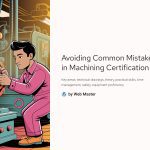 Embarking on the journey to acquire a machining certification is a commendable endeavor that can significantly enhance your career prospects in the manufacturing and engineering sectors. However, candidates often encounter pitfalls that can impede their progress. This guide aims to highlight these common mistakes and provide actionable strategies to help you navigate the certification process successfully.
Embarking on the journey to acquire a machining certification is a commendable endeavor that can significantly enhance your career prospects in the manufacturing and engineering sectors. However, candidates often encounter pitfalls that can impede their progress. This guide aims to highlight these common mistakes and provide actionable strategies to help you navigate the certification process successfully.

Inadequate Understanding of Technical Drawings
A prevalent challenge among candidates is the misinterpretation of technical drawings. These drawings are the blueprint for machining tasks, and any misunderstanding can lead to errors in the final product.
- Study Diverse Drawings: Engage with a variety of technical drawings to familiarize yourself with different symbols, notations, and conventions.
- Focus on Dimensions and Tolerances: Pay close attention to specified measurements and allowable deviations to ensure precision in machining.
- Understand Assembly Sequences: Grasp the relationship between components and their assembly order to facilitate efficient and accurate construction.
Insufficient Theoretical Knowledge
While practical skills are essential, a strong theoretical foundation is equally important. Neglecting the underlying principles can result in a superficial understanding of machining processes.
- Master Core Subjects: Delve into subjects such as material science, mechanics, and machining principles to build a robust knowledge base.
- Utilize Educational Resources: Take advantage of textbooks, online courses, and workshops that cover the theoretical aspects of machining.
- Apply Theory to Practice: Regularly connect theoretical concepts to practical applications to reinforce learning and comprehension.

Neglecting Practical Application
Overemphasis on theory at the expense of hands-on practice can leave candidates ill-prepared for real-world scenarios.
- Engage in Regular Workshops: Participate in machining workshops or lab sessions to apply theoretical knowledge practically.
- Seek Apprenticeship Opportunities: Gain experience under the mentorship of seasoned professionals to hone your skills.
- Simulate Real-World Projects: Undertake projects that mimic industry tasks to build confidence and competence.

Poor Time Management
Effective time management is crucial, especially during the certification exams, which often have strict time constraints.
- Develop a Study Schedule: Allocate specific time blocks for studying different topics and stick to the schedule diligently.
- Practice Timed Exercises: Simulate exam conditions by completing practice tasks within set time limits to improve efficiency.
- Prioritize Tasks: Identify areas that require more attention and focus on them without neglecting other subjects.

Overlooking Safety Protocols
Safety is paramount in machining. Ignoring safety guidelines can lead to accidents and disqualification during practical assessments.
- Learn Safety Standards: Familiarize yourself with industry-standard safety protocols and ensure strict adherence.
- Use Protective Gear: Always wear appropriate personal protective equipment (PPE) such as gloves, goggles, and hearing protection.
- Maintain a Clean Workspace: Keep your work area organized to prevent accidents and ensure a conducive environment for machining tasks.

Inadequate Familiarity with Equipment
A lack of proficiency with machining tools and equipment can hinder performance during practical exams.
- Hands-On Practice: Spend ample time operating various machines to understand their functionalities and nuances.
- Attend Equipment Training Sessions: Participate in training programs that focus on the proper use and maintenance of machining tools.
- Stay Updated on Technological Advances: Keep abreast of the latest developments in machining technology to enhance your skill set.
Conclusion
Achieving a machining certification requires a balanced approach that integrates theoretical knowledge, practical skills, and strict adherence to safety protocols. By being mindful of the common mistakes outlined above and implementing the suggested strategies, you can enhance your proficiency and increase your chances of success in obtaining your certification.
Q&A
Q1: How can I improve my understanding of technical drawings?
A1: Engage with a variety of technical drawings, focus on learning the symbols and notations, and consider taking specialized courses in technical drawing interpretation.
Q2: What resources are recommended for strengthening theoretical knowledge in machining?
A2: Utilize textbooks on machining principles, enroll in online courses, and attend workshops that cover both fundamental and advanced topics in machining.
Q3: How important is safety during the certification process?
A3: Safety is critical. Adhering to safety protocols not only prevents accidents but also demonstrates professionalism and competence during assessments.
Q4: What strategies can help with time management during exams?
A4: Develop a structured study schedule, practice with timed exercises, and prioritize topics based on your strengths and weaknesses to manage time effectively.
Q5: How can I gain practical experience with machining equipment?
A5: Seek out workshops, apprenticeships, or training programs that offer hands-on experience with various machining tools and equipment.
*Capturing unauthorized images is prohibited*


